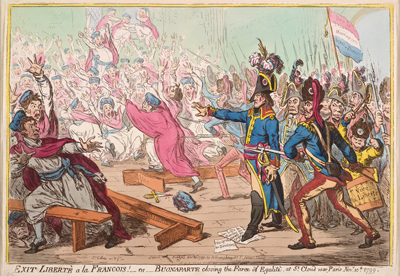Exit Libertè a la Francoise!
The full title of this print is Exit Libertè a la Francois! or Buonaparte closing the Farce of Egalitè, at St cloud near Paris Novr 10th 1799. It purports to show the moment when Buonaparte put an effective end to the rule of the French Directory by entering the Orangerie where the Council of Five Hundred (the lower house of the legislature) had been meeting, dispersing its members by a show of military force. If the note on the floor (which Napoleon treads upon) did not make it clear that this IS the Council of Five Hundred, the members all wear the ceremonial robes designed by Jacques-Louis David and which Gillray had depicted in French Habits No. 3: Les Membres du Conseil des Cinq Cents (1798).

© Trustees of the British Museum
The print manages to dramatize or allude to many of the salient features of Napoleon's coup d'etat which transpired over two days as reported in the London newspapers.
It all began on 9 November with the leader of the Council of 500 (Lucien Buonaparte) persuading both upper and lower Councils that a Jacobin coup in Paris was imminent (a lie) and that they would be safer to hold their Councils outside of Paris at the Château de Saint-Cloud. In a classic case of the fox guarding the hen house, the popular Napoleon Buonaparte, recently returned supposedly in triumph (also a lie) from Egypt, was put in charge of troops to safeguard the Councils.
Meanwhile, two of the five executive Directors, the Abbé Sieyès, and Roger Ducos, who were part of the plot resigned, leaving only the thoroughly corrupt and eminently bribable Paul Barras to resign in order to render a Directory quorum impossible. Barras, of course, obliged. The two remaining and recalcitrant Directors were detained in Paris and later arrested. This part of the plot is alluded to in Gillray's print with the paper at Buonaparte's feet, "Resignation[s} des Directoires."
By the next day, when the Councils assembled in St Cloud, it was becoming apparent that far from being protected, the Councils were in the gravest danger from Napoleon himself and the troops that now surrounded the Chateaux. And when Napoleon appeared in the halls and attempted to address the Councils himself, he was greeted with open hostility and in the jostling that resulted, by some accounts, Naploeon's face and arm were bloodied. Realizing that the coup was in jeopardy, the two Buonapartes returned to the troops, convincing them that the great majority of the Council was being terrorized by deputies bearing daggers and that Napoleon's "wounds" were the result of attacks by brigands set on by Britain. Hence the dagger on the floor of the chamber.
Later the same day, the Council of Ancients, the upper house of the legislature, was "persuaded" to pass a decree that suspended further Council meetings and made Buonaparte, the Abbé Sieyès, and Roger Ducos provisional Consuls. In Gillray's print that is shown as a fait accompli with one of the troops carrying a tri-color banner already inscribed with "Vive le Triumverate" and the the names of the three provisional consuls. It is surely no accident that Buonaparte's name appears above that of Sieyès and Ducos, and that Buonaparte appears in the chamber using the commanding gesture seen in images of Octavius Caesar, another member of a triumvirate who ultimately became Emperor.
Sources and Reading
- Commentary from the British Museum on Exit Liberte a la Francoise!.
- Tim Clayton & Sheila O'Connell, Bonaparte and the British, 2015, #33, p. 87.
- Draper Hill, Mr. Gillray The Caricaturist, 1965, pp. 125 -126. Pl. 117.
- "Coup of 18 Brumaire," Wikipedia
- "Roger Ducos," Wikipedia
- "Napoleon," Wikipedia
- "Emmanuel Joseph Sieyès," Wikipedia
- Robert Harvey, The War of Wars, London, 2006.
- Felix Markham, Napoleon, New York 2010.
- Thomas Wright and R.H. Evans, Historical and Descriptive Account of the Caricatures of James Gillray #248.
- Thomas Wright and Joseph Grego, The Works of James Gillray, the Caricaturist; With the History of His Life and Times, p. 262.
Comments & Corrections
NOTE: Comments and/or corrections are always appreciated. To make that easier, I have included a form below that you can use. I promise never to share any of the info provided without your express permission.